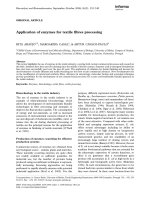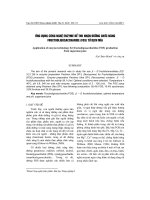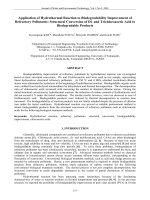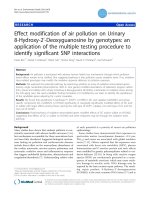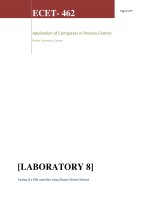application of core principles of chemistry
Bạn đang xem bản rút gọn của tài liệu. Xem và tải ngay bản đầy đủ của tài liệu tại đây (453.84 KB, 24 trang )
Centre Number Candidate Number
Write your name here
Surname Other names
Total Marks
Paper Reference
Turn over
Chemistry
Advanced Subsidiary
Unit 2: Application of Core Principles of Chemistry
6CH02/01
Wednesday 3 June 2009 – Morning
Time: 1 hour 15 minutes
Candidates may use a calculator.
Instructions
•
Use black ink or ball-point pen.
•
Fill in the boxes at the top of this page with your name,
centre number and candidate number.
•
Answer all questions.
•
Answer the questions in the spaces provided
– there may be more space than you need.
Information
•
The total mark for this paper is 80.
•
The marks for each question are shown in brackets
– use this as a guide as to how much time to spend on each question.
•
Questions labelled with an asterisk (*) are ones where the quality of your
written communication will be assessed
– you should take particular care with your spelling, punctuation and grammar,
as well as the clarity of expression, on these questions.
•
A Periodic Table is printed on the back cover of this paper.
Advice
•
Read each question carefully before you start to answer it.
•
Keep an eye on the time.
•
Try to answer every question.
•
Check your answers if you have time at the end.
H34472A
©2009 Edexcel Limited.
7/7/3/
*H34472A0124*
Edexcel GCE
2
*h34472A0224*
SECTION A
Answer ALL the questions in this section. You should aim to spend no more than 20 minutes on
this section. For each question, select one answer from A to D and put a cross in the box
.
If you change your mind, put a line through the box
and then mark your new answer with a
cross
.
1 What is the oxidation number of chlorine in the ClO
3
–
ion?
A –1
B +4
C +5
D +6
(Total for Question 1 = 1 mark)
2 Which of these reactions is not a redox reaction?
A Mg(NO
3
)
2
(s) → MgO(s) + 2NO
2
(g) + ½O
2
(g)
B HCl(aq) + NaOH(aq) → NaCl(aq) + H
2
O(l)
C Fe(s) + CuSO
4
(aq) → FeSO
4
(aq) + Cu(s)
D Cl
2
(aq) + 2Br
–
(aq) → 2Cl
–
(aq) + Br
2
(aq)
(Total for Question 2 = 1 mark)
Use this space for any rough working. Anything you write in this space will gain no credit.
3
*h34472A0324*
Turn over
3 Which of these carbon structures is represented by the diagram below?
A Graphite
B Diamond
C A fullerene
D A carbon nanotube
(Total for Question 3 = 1 mark)
4 What colour precipitate would you expect to see if 1-bromopropane was heated with a
solution of silver nitrate?
A Orange
B White
C Yellow
D Cream
(Total for Question 4 = 1 mark)
5 Which of these bond angles is the smallest?
A HNH in NH
3
B HCH in CH
4
C HOH in H
2
O
D OCO in CO
2
(Total for Question 5 = 1 mark)
4
*h34472A0424*
6 Which statement best describes the shape and bond angles in the molecule SF
6
?
A Octahedral, 90° and 180°
B Trigonal bipyramidal, 90° and 180°
C Octahedral, 90° and 120°
D Trigonal bipyramidal, 90° and 120°
(Total for Question 6 = 1 mark)
7 Which of the following values for the mass/charge ratio for singly charged ions would
be present in the mass spectrum of propanal, CH
3
CH
2
CHO, but not of propanone,
CH
3
COCH
3
?
A 15
B 29
C 43
D 58
(Total for Question 7 = 1 mark)
Use this space for any rough working. Anything you write in this space will gain no credit.
5
*h34472A0524*
Turn over
8 The infrared spectrum below is most likely to be that of a member of which homologous
series?
C Cl stretching vibrations 600 – 800 cm
–1
O H stretching vibrations 2500 – 3300 cm
–1
C O stretching vibrations 1680 – 1740 cm
–1
A Alcohol
B Chloroalkane
C Aldehyde
D Carboxylic acid
(Total for Question 8 = 1 mark)
Use this space for any rough working. Anything you write in this space will gain no credit.
Transmittance
/%
4000 3000 2000 1500 1000 500
100
50
0
Wavenumber / cm
–1
6
*h34472A0624*
9 In the reaction profile below, which energy change would alter if a catalyst was added to
the reaction?
A
B
C
D
(Total for Question 9 = 1 mark)
Use this space for any rough working. Anything you write in this space will gain no credit.
B
Reaction co-ordinate
D
CA
Products
Reactants
Energy
7
*h34472A0724*
Turn over
10 In the equilibrium below, what effect would the changes described have on the system?
2H
2
S(g) + SO
2
(g) U 3S(s) + 2H
2
O(g) ∆H is negative
(a) Increase in temperature
(1)
A increase rate, decrease yield
B increase rate, increase yield
C decrease rate, decrease yield
D decrease rate, increase yield
(b) Decrease in pressure
(1)
A increase rate, decrease yield
B increase rate, increase yield
C decrease rate, decrease yield
D decrease rate, increase yield
(Total for Question 10 = 2 marks)
Use this space for any rough working. Anything you write in this space will gain no credit.
8
*h34472A0824*
11 What is the correct systematic name for the alcohol shown below?
A hexan-4-ol
B hexan-2-ol
C pentan-4-ol
D pentan-2-ol
(Total for Question 11 = 1 mark)
12 Which of these compounds is a secondary halogenoalkane?
A CH
3
CH(OH)CH
3
B CH
3
CCl(CH
3
)CH
3
C CH
3
CHClCH
3
D CH
3
CH
2
CH
2
Cl
(Total for Question 12 = 1 mark)
13 The bonding in gaseous hydrogen halides is best described as
A mainly covalent with an increasing tendency towards ionic as you go down the
group.
B mainly covalent with an increasing tendency towards ionic as you go up the
group.
C mainly ionic with an increasing tendency towards covalent as you go down the
group.
D mainly ionic with an increasing tendency towards covalent as you go up the
group.
(Total for Question 13 = 1 mark)
OH
9
*h34472A0924*
Turn over
14 What would be the colour of the solution when iodine is dissolved in a hydrocarbon
solvent?
A Grey
B Brown
C Yellow
D Purple
(Total for Question 14 = 1 mark)
15 Starch is often used as an indicator in titrations between sodium thiosulfate and iodine
solutions. What colour change would you see at the end-point as sodium thiosulfate is
added to iodine solution in the presence of starch?
A Yellow to colourless
B Colourless to yellow
C Blue-black to colourless
D Colourless to blue-black
(Total for Question 15 = 1 mark)
16 An electric field can affect the direction of a stream of some liquids. Which of these
liquids would be affected by an electric field?
A 1-chloropropane
B Pentane
C Tetrachloromethane
D Cyclopentane
(Total for Question 16 = 1 mark)
Use this space for any rough working. Anything you write in this space will gain no credit.
10
*h34472A01024*
17 Which of these isomers has the highest boiling temperature?
A
B
C
D
(Total for Question 17 = 1 mark)
18 Which of the following statements is true?
A Calcium hydroxide is more soluble in water than magnesium hydroxide.
B Chlorine is more electronegative than fluorine.
C Iodine is a stronger oxidizing agent than bromine.
D The first ionization energy of barium is greater than that of strontium.
(Total for Question 18 = 1 mark)
19 Iodine can react with sodium hydroxide solution to form NaIO
3
(aq), according to the
equation below.
3I
2
(aq) + 6NaOH(aq) → 5NaI(aq) + NaIO
3
(aq) + 3H
2
O(l)
Which of the statements about the reaction is false?
A The oxidation number of some iodine atoms goes up.
B At high temperatures NaIO(aq) also forms.
C Sodium ions are spectator ions.
D The oxidation number of some iodine atoms goes down.
(Total for Question 19 = 1 mark)
TOTAL FOR SECTION A = 20 MARKS
11
*h34472A01124*
Turn over
SECTION B
Answer ALL the questions. Write your answers in the spaces provided.
20 When 2-chloro-2-methylpropane is heated in a mixture of water and ethanol at 65 °C,
two types of reaction occur. A mixture of two organic products, 2-methylpropan-2-ol
and 2-methylpropene, is formed.
(a) (i) Name the two reaction types that are taking place.
(2)
Reaction 1
Reaction 2
*(ii) Explain how the two products form, by describing the role of the water in each
case.
(4)
Reaction 1
Reaction 2
H CCCH
H
H
CH
3
H
HCl
H
C CCH
H
H
CH
3
H
HOH
H CCC
H
H
CH
3
H
H
Reaction 1
Reaction 2
12
*h34472A01224*
(b) A proposed mechanism for Reaction 1 involved the formation of the carbocation,
(i) What type of bond breaking must have occurred during the carbocation
formation?
(1)
(ii) Suggest why 1-chlorobutane reacts with water via a different mechanism.
(2)
(c) Another halogenoalkane, 2-chlorobutane, behaves in a similar way to
2-chloro-2-methylpropane but in Reaction 2 can form three different alkenes.
Suggest how three different alkenes can form and give their displayed formulae.
(4)
H
3
C C
+
CH
3
CH
3
13
*h34472A01324*
Turn over
(d) Suggest why 2-fluoro-2-methylpropane would react more slowly than
2-chloro-2-methylpropane in Reaction 1.
What reagent could you use instead of water to increase the rate of this reaction
involving 2-fluoro-2-methylpropane? Explain why the reagent would have this
effect.
(3)
(Total for Question 20 = 16 marks)
14
*h34472A01424*
21 The graph below shows the boiling temperatures of the hydrides of Group 7.
Boiling temperatures of Group 7 hydrides
(a) (i) Identify the type of intermolecular force that gives rise to the unusually high
boiling temperature of hydrogen fluoride.
(1)
(ii) State and explain whether the electronegativity of fluorine is greater than,
similar to or less than, that of bromine.
Hence explain why hydrogen fluoride can form the type of intermolecular force
named in (a)(i) but hydrogen bromide cannot.
(3)
15
*h34472A01524*
Turn over
(iii) Use the graph to predict what the boiling temperature of hydrogen fluoride
would be without the presence of the type of intermolecular force named in
(a)(i).
(1)
(b) Propanone, CH
3
COCH
3
, is a useful solvent for cleaning glassware in laboratories.
(i) Why is propanone able to dissolve a wide range of substances?
(1)
(ii) Propanone can be used to remove both water and octane from glassware.
For each of these substances, identify the strongest intermolecular force formed
with propanone and the feature of the propanone molecule involved.
(2)
Water
Octane
(Total for Question 21 = 8 marks)
16
*h34472A01624*
22 Calcium oxide, known as quicklime, is produced by the thermal decomposition of
calcium carbonate, found naturally in limestone.
(a) (i) Explain what is meant by the term thermal decomposition.
(2)
(ii) Write an equation for the thermal decomposition of calcium carbonate, including
state symbols.
(1)
(iii) Other Group 2 carbonates can also undergo thermal decomposition. Describe
and explain the trend in thermal stability of carbonates down Group 2.
(3)
17
*h34472A01724*
Turn over
(b) 0.121 g of an impure sample of quicklime was dissolved in 50.0 cm
3
of hydrochloric
acid, concentration 0.100 mol dm
–3
. The excess hydrochloric acid was titrated with
sodium hydroxide solution, concentration 0.100 mol dm
–3
, and 18.0 cm
3
was needed
to just neutralize the acid. The indicator used was methyl orange.
The equations for the reactions involved are shown below.
CaO(s) + 2HCl(aq) → CaCl
2
(aq) + H
2
O(l)
HCl(aq) + NaOH(aq) → NaCl(aq) + H
2
O(l)
(i) What colour would the indicator be at the end-point?
(1)
(ii) Calculate the number of moles of hydrochloric acid that reacted with the
sodium hydroxide solution.
(1)
(iii) Calculate the number of moles of hydrochloric acid originally added to the
quicklime. Use this answer and your answer to (b)(ii) to calculate the number
of moles of quicklime that reacted with the hydrochloric acid.
(2)
(iv) Calculate the percentage purity of the sample of quicklime. Give your answer
to three significant figures.
(2)
18
*h34472A01824*
(c) (i) Describe how to carry out a flame test on the impure sample of quicklime to
confirm that it contains calcium ions.
(3)
(ii) If the flame test gave a green colour, in addition to the expected brick red flame,
which Group 2 metal is also likely to be present?
(1)
(Total for Question 22 = 16 marks)
TOTAL FOR SECTION B = 40 MARKS
19
*h34472A01924*
Turn over
SECTION C
Answer ALL the questions. Write your answers in the spaces provided.
23
As levels of fossil fuel resources are getting lower, society is increasingly looking at
the use of biofuels as alternatives to coal, oil and gas. Biofuels are derived from plants
and examples include bioethanol, biodiesel and Miscanthus, a plant more commonly
known as elephant grass. These fuels have the advantage of being renewable and the
plants take in carbon dioxide as they grow.
Bioethanol is produced from crops such as sugar cane or corn. The raw plant material
is treated to produce a sugary solution which is then fermented to produce ethanol,
water and carbon dioxide gas. The ethanol is removed by distillation. The resulting
solution contains about 96 % ethanol. The remaining water has to be removed by
absorption using a suitable drying agent so that the ethanol can burn efficiently. The
bioethanol can then be burnt alone or mixed with petrol in vehicle engines.
Biodiesel is formed by the hydrolysis of vegetable oils using sodium hydroxide
solution, followed by esterification with methanol and a sodium hydroxide catalyst.
Biodiesel can then be used on its own in diesel-engined vehicles or mixed with diesel
derived from crude oil. Plants which are used to produce the vegetable oils include
rapeseed in the UK, soya bean in the USA and palm oil in Asia.
Miscanthus, or elephant grass, is a quick growing, high-yield plant that grows up to
four metres in height. After harvesting, the grass is left to dry and then burnt in power
stations designed to run on solid fuels such as coal. In the United Kingdom, farms that
produce elephant grass are normally situated within 50 miles of such a power station.
In an experiment to simulate the production of bioethanol, a student produced a water/
ethanol mixture by fermentation of sucrose solution using yeast. It was then proposed
to separate the ethanol from water by carrying out a distillation on the mixture. The
mixture would then be dried using a suitable drying agent.
(a) Draw a diagram to show the most significant intermolecular force between an
ethanol molecule and a water molecule. Label the bond angle between the molecules
and state its value.
(2)
20
*h34472A02024*
(b) The student proposed to set up the apparatus as shown below to carry out the
distillation to try to separate the ethanol from water.
There are three errors with the set-up. Draw a circle around each error.
Describe what effect these errors would have if the student attempted to carry out the
separation as shown.
[Clamps are not shown in the diagram but you can assume the apparatus is supported
adequately.]
(6)
Heating mantle
Anti-bumping
beads
21
*h34472A02124*
Turn over
(c) If a balance accurate to two decimal places was used to record the mass of ethanol
collected, what would be the percentage error due to the balance readings if the total
mass of ethanol collected was 20.10 g?
(1)
(d) Suggest a suitable drying agent to absorb the water remaining with the ethanol after
distillation. Describe how you would use it to produce a dry sample of ethanol.
(2)
22
*h34472A02224*
(e) Describe a chemical test you could carry out to confirm the presence of the
–OH group in ethanol. What result would you expect to see?
(2)
Test
Result
(f) *(i) Explain what is meant by a carbon neutral fuel.
(2)
*(ii) Suggest TWO reasons why these biofuels may not be carbon neutral and
describe TWO effects that large scale production of biofuels may have on
society. Which of the three biofuels do you think is the most sustainable?
Justify your choice.
(5)
23
*h34472A02324*
(Total for Question 23 = 20 marks)
TOTAL FOR SECTION C = 20 MARKS
TOTAL FOR PAPER = 80 MARKS
24
*h34472A02424*

